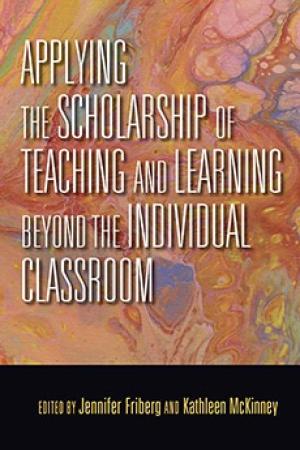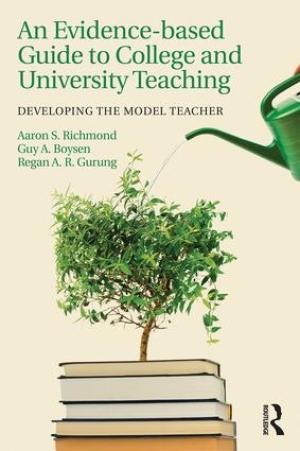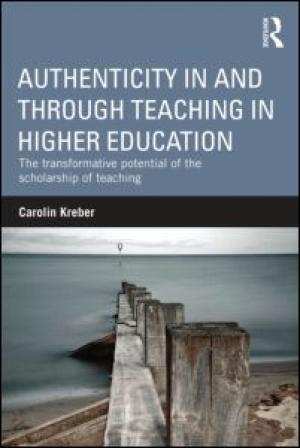Resources

When the Scholarship of Teaching and Learning (SoTL) emerged, it often concentrated on individual faculty practice in one classroom; it is now, however, increasingly common to find work in SoTL focused more broadly. SoTL studies may engage with a cluster of courses, a program, a particular population of students, a pedagogical approach, or a field—all of which are represented in the essays collected here by authors from a diverse array of institutions and nations. This volume features examples of SoTL research conducted in, and applied to, a variety of contexts and disciplines, offering a theoretical framework for an expanded vision of SoTL—one that moves beyond the individual classroom. (From the Publisher)

Many changes in higher education have derived from Europe-wide initiatives such as the Bologna process, and have given increasing attention to student-centred learning and teaching approaches, allied to growth in teachers’ scholarship and academic development. Academic Growth in Higher Education: Questions and Answers centers around a decade-long research project, which is one component of a long-standing programme focused on ways to promote academic development and scholarship in higher education. The purpose of the book is to highlight debates and issues important in teaching and learning at the tertiary level in universities, colleges and schools – exploring issues that teachers and lecturers will need to address throughout their professional lives. These issues surround acts of student-centred learning, inquiry-based learning, teachers’ own practices in the classroom and, every bit as significant, the activities generated by their students in the process of learning. The intention is to identify some of the debates relevant to teaching and learning, to challenge some of the orthodoxies within traditional forms of teaching and learning, and to suggest some solutions though current practice over a wide context of activity. (From the Publisher)

Richmond, Boysen, and Gurung’s work provides a much-needed resource for new teachers and is valuable to experienced teachers as well. The text is both concise and comprehensive concerning the current state of the Scholarship of Teaching and Learning (SoTL). The authors are psychologists who include their disciplinary insights, as well as provide important examples and resources from disciplines in the sciences, social sciences, and humanities. Chapters one and two set up the context of the “model teacher.” Rather than providing an essentialist answer to the definition of the model teacher, the authors focus on behaviors that produce consistent ideal results in the classroom. Chapters three through five – focused on teacher training, instructional methods, and student learning respectively – are useful to new teachers. As a text for initiating teachers, these chapters provide a reliable systematic introduction to key ways in which teachers interact with students in the classroom. These chapters should be complemented with discipline-specific examples or readings in graduate school teaching programs. Chapters six and seven on assessment of student learning and syllabus construction are the most valuable to teachers at any stage in their career. The insights into the scholarship on assessment is invaluable for the development of class, departmental, and university-wide curriculum. These two chapters are the most practical chapters for reconsidering the significance and purpose of teaching strategies and assignments. Finally, chapter eight examines student evaluations. There are many important insights in this chapter for new teachers on how to engage meaningfully with student summative evaluations. One point of interest was the authors’ statement on the significance of student satisfaction with a course. The authors could have included a lengthier conversation on how to meaningfully address the question of student satisfaction. In the end, “evidence-based” means that one organizes the multiple resources we employ in higher education in a way that substantiates the claims we wish to make. This text provides concrete advice that is useful for the novice; it is also a helpful aid for anyone wishing to mentor others in the art of teaching. An Evidence-based Guide to College and University Teaching employs an engaging hypothetical dialogue with the reader and an interactive approach. There are self-assessments at the beginning and end of each chapter along with hypothetical case studies for each chapter. An appendix at the end presents the uninterrupted self-assessment scale on sixty-four criteria for model teachers. These elements are excellent resources for group discussion in graduate seminars or faculty retreats. This book presents an accessible synthesis of the SoTL literature. It is successful as a gateway resource to the dialogue from the last forty years on pedagogical best practices. The text is limited in terms of the depth that it covers given the myriad topics it addresses, but it provides a solid beginning to engage the conversation.

This book explores the role of authenticity in higher education. Kreber’s work contributes to the Scholarship of Teaching and Learning movement, which includes post-secondary educators from a variety of disciplines who emphasize teaching as a scholarly discipline in its own right (Huber and Morreale, Disciplinary Styles in the Scholarship of Teaching and Learning: Exploring Common Ground [Washington, D.C.: AAHE] 2002). Kreber criticizes the movement, however, for being insufficiently attentive to issues of power and social justice, and she posits her research as a corrective (5). Authenticity, Kreber argues, involves not only reflective awareness of one’s own inner motives and dispositions, but also critical consciousness of the power relations that determine one’s place in the social order (26-27, 38-39). Authenticity inteaching promotes awareness of one’s positionality as a teacher (50-52, 133-140, 171), and it leads one to serve the best interests of one’s students. Authenticity through teaching, meanwhile, defines, and ultimately attains, the students’ ultimate interest: coming into their own authenticity. Higher education thus comes to promote a more just and sustainable world (44-49). Authenticity In and Through Teaching unfolds in eight chapters, plus a conclusion. Chapter 1 engages philosophical and pedagogical literature to interrogate the concept of authenticity. Chapter 2 contains Kreber’s core argument, summarized above. In Chapter 3, Kreber explores the implications for the Scholarship of Teaching and Learning movement, arguing that it is distinguished from pedagogical theory by its reflective stance: it involves the application of research to one’s own teaching practice (75). For these reasons, in Chapter 7 she challenges the notion of the scholarship of teaching as an evidence-based practice. In Chapter 4, she draws on Alasdair MacIntyre’s unique connection between practice and virtue to argue for a moral imperative in teaching practice (MacIntyre, After Virtue: A Study in Moral Theory [Notre Dame, Ind.: University of Notre Dame Press] 2007). Chapters 5 and 6 invoke the critical self-reflection inherent to authenticity as a means to counteract the distorting effects of power in the university classroom. Chapter 8, finally, argues that authentic scholarship of teaching and learning demands public engagement. Operating within the framework of engaged pedagogy, Authenticity In and Through Teaching provides a useful, coherent, and comprehensible framework for conceptualizing the practice of teaching. It also serves as a point of entry to contemporary scholarly literature in several disciplines, including pedagogical theory, moral and existential philosophy, and critical social theory. Finally, the moral imperative that Kreber derives from her understanding of authenticity, rooted as it is in virtue theory, would be particularly applicable in liberal arts and seminary contexts (where the moral shaping of the student is part of the educational process). I recommend this book for scholar-teachers who want to expand their awareness of theoretical literature on pedagogy and bring it to bear on their teaching practice.